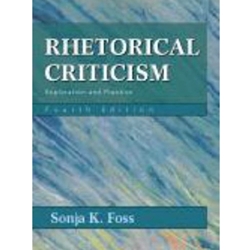- Foss Rhetorical Criticism 5th Edition
- Rhetorical Criticism Textbook Foss
- Foss Rhetorical Criticism 3rd Edition
- Rhetorical Criticism: Exploration And Practice Foss
- Foss Rhetorical Criticism Pdf

Foss Rhetorical Criticism 5th Edition
The Nature of Rhetorical Criticism 7 they do. We tend to respond to these symbols by saying 'I like it' or iII don't like it./I The process of rhetorical criticism involves engaging in this natural process in a more conscious, systematic, and focused way. Through the study and practice of rhetorical criticism, we can under. Rhetorical criticism. At the same time, however, the book's emphasis on rules for conducting analysis coupled with its epistemological approach may prove to be somewhat limiting for introducing students to the art of rhetorical criticism. Theoretically, Foss takes an expansive view of rhetorical criticism. Foss identifies four major steps in 'the process of doing rhetorical criticism': 1) discovery of the artifact and research question. 2) formulation of the critical method. 3) critical analysis of the artifact. 4) writing the critical essay.
- 7.1: Rhetorical Criticism Overview
- 7.2: Rhetoric In Ancient Times
- 7.3: Understanding Rhetorical Criticism
- In the second half of this chapter we would like to discuss a close associate to rhetorical theory—rhetorical criticism. To explain this exciting subdiscipline we will discuss the scope of rhetorical criticism, the purpose of this method, the kinds of knowledge produced, and the relationship between rhetorical theory and criticism. We will conclude with examples of how rhetorical criticism seeks to answer contemporary socio and political concerns.
- 7.4: Current Uses of Rhetorical Theory and Criticism
- By now you should have a clear understanding of what rhetorical theory and criticism are and the uses they serve for the discipline as well as the world outside academia. We would like to conclude this chapter by detailing some of the current issues and questions occupying rhetorical scholars. As the examples are numerous, we will speak to three specific content areas: the study of social movements, political and campaign rhetoric, and studies of popular culture.
- 7.5: Rhetorical Criticism Summary
- 7.6: Rhetorical Criticism References
Rhetorical Criticism Textbook Foss

Foss Rhetorical Criticism 3rd Edition

Rhetorical Criticism: Exploration And Practice Foss

Foss Rhetorical Criticism Pdf
- 7.1: Rhetorical Criticism Overview
- 7.2: Rhetoric In Ancient Times
- 7.3: Understanding Rhetorical Criticism
- In the second half of this chapter we would like to discuss a close associate to rhetorical theory—rhetorical criticism. To explain this exciting subdiscipline we will discuss the scope of rhetorical criticism, the purpose of this method, the kinds of knowledge produced, and the relationship between rhetorical theory and criticism. We will conclude with examples of how rhetorical criticism seeks to answer contemporary socio and political concerns.
- 7.4: Current Uses of Rhetorical Theory and Criticism
- By now you should have a clear understanding of what rhetorical theory and criticism are and the uses they serve for the discipline as well as the world outside academia. We would like to conclude this chapter by detailing some of the current issues and questions occupying rhetorical scholars. As the examples are numerous, we will speak to three specific content areas: the study of social movements, political and campaign rhetoric, and studies of popular culture.
- 7.5: Rhetorical Criticism Summary
- 7.6: Rhetorical Criticism References